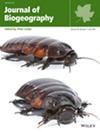Bridging the Gap Between Lagrangian and Eulerian Species Distribution Models for Abundance Estimation—A Simulation Experiment
Abstract
Aim
In mobile species, individual movement decisions based on biotic and abiotic conditions determine how individuals interact with the environment, heterospecifics and conspecifics. Accordingly, these decisions underpin all ecological principles and structure broader spatial patterns at the population and species level. Species distribution models (SDMs) are therefore paramount in ecology, with implications for both fundamental and applied studies. There are many robust SDM techniques, from individual-scale (Lagrangian) to population-scale (Eulerian) models. Their outputs routinely support wildlife management, conservation, or risk assessments. Yet, it remains unclear whether SDMs built at individual and population scales infer the same processes, and whether the spatial distributions they predict are comparable. Here, we address this key question with a simulation exercise.
Location
Virtual environment.
Taxon
Virtual species.
Methods
First, we simulated the individual movements of two highly mobile species, one central-place forager and one free ranger. Second, we surveyed the species at the individual-scale, replicating Lagrangian studies by tracking individual movements, and at the population-scale, replicating Eulerian surveys by censusing the study area with standardised protocols. The resulting data were analysed following well-established statistical methods to assess species abundance distribution. We used Resource Selection Functions (RSFs) for Lagrangian data and Density Surface Models (DSMs) for Eulerian data.
Results and Main Conclusions
Both Lagrangian and Eulerian SDMs adequately estimated the species' relationship with environmental conditions. Although some fine-scale differences occurred, both perspectives yielded highly correlated spatial distributions (correlations of 0.8–1.0 between pairs of models), and successfully predicted true abundance distributions (correlations of 0.6–0.7 with the true abundance distribution). Our results demonstrate that Lagrangian and Eulerian SDMs are statistically consistent and directly comparable, which is of great importance for conservation science. This provides crucial guidance for the combination of predictions from both model types to inform spatial planning within a wide range of management contexts.


 求助内容:
求助内容: 应助结果提醒方式:
应助结果提醒方式:


